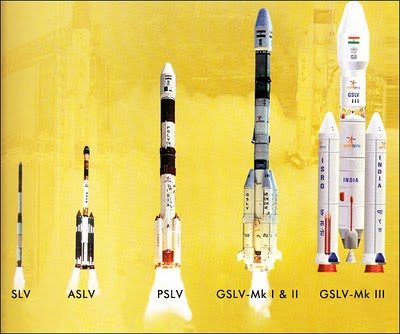Now, ISRO Well on Course to Test Launch Rocket Giant - The New Indian Express
Work on India's most powerful rocket to date, scheduled for an experimental flight in April, is progressing fast.
The first stage of the hefty Geosynchronous Satellite Launch Vehicle Mk-III (GSLV Mk-III) is ready, officials of Vikram Sarabhai Space Centre (VSSC) here said.
Two S-200 boosters, which use solid fuel, comprise the first stage of Mk-III. This stage will burn for 130 seconds. "The stage is ready. Work is now progressing on the second stage at the Liquid Propulsion Systems Centre (LPSC) in Mahendragiri," VSSC director S Ramakrishnan said. The GSLV Mk-III has three 'stages' in all.
The second stage uses liquid fuel - Unsymmetrical Dimethylhydrazine (UDMH) with Dinitrogen Tetroxide. This stage - L 110 - has two advanced Vikas engines and will burn for 200 seconds. The upper, third stage uses a more powerful version of the cryogenic engine used on the recent GSLV D-5 mission. The engine has been designated CE-2O and uses Liquid Oxygen and Liquid Hydrogen as fuel. Theoretically, this stage will burn for 580 seconds, but the April flight being an experimental one, the cryo stage won't be carrying propellant.
Tests are currently progressing on the engine at present, LPSC director M C Dathan said on the sidelines of a reception given to ISRO scientists here on Monday. ''The third test has been conducted successfully,'' he said.
At 42.4 metres, Mk-III is shorter than the regular GSLV, but it has a lift-off weight of around 630 tonnes compared to the latter's 400 tonnes. Mk-III can place satellites weighing up to four tonnes in the geostationary transfer orbit, giving ISRO an edge in the market. If everything goes according to plan, the assembly of the rocket will begin at the Satish Dhawan Space Centre, Sriharikota, in February.
"The GSLV Mk-III will have a sub-orbital flight in April. It will have as payload a prototype of the crew module meant for the manned mission," Ramakrishnan said.
Mk-III will lift off from the second launchpad at Sriharikota, the same one the GSLV D-5 used on January 5. No modifications will be needed to the launchpad as it can accommodate the bigger GSLV, Ramakrishnan said. A regular flight of the Mk-III version is expected only by 2016.











